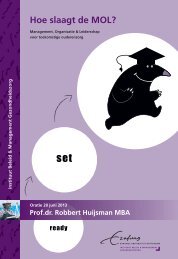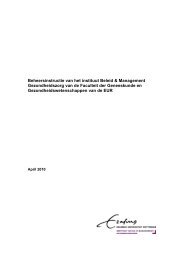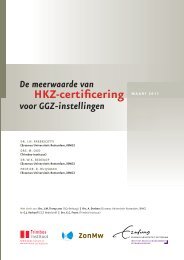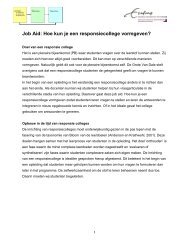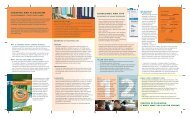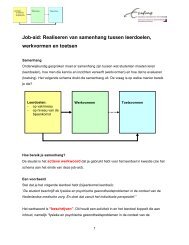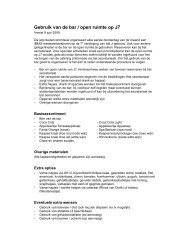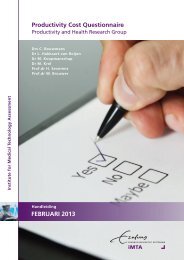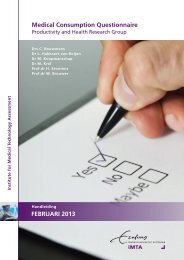46Chapter 3Regarding the treatment of CDH patients, ECMO is the subject for debate. Thecurrent study brings us to the following reflections about ECMO. The averagecosts of a treatment including ECMO (€ 35,718) appear not to be much more thanthe costs of a treatment without ECMO (€ 32,376; Table 3.2). One possibleexplanation is that there is an interaction between the use of ECMO and the totallength of stay in a neonatal intensive care unit. A few findings suggest that ECMOmight shorten the length of stay in patients with severe respiratory illness (i.e.,not only CDH patients). 26-29 This will have a negative influence on overall directmedical costs. Because of the small patient numbers (caused by the lack ofcomputerized data), we could not test this assumption in this study. However,there might be a more likely explanation. Six of the 8 patients that underwentECMO treatment died, in comparison with 27% of the others. The small patientnumbers may have impeded representative survival rates. In larger study groups,survival rates in ECMO patients and thus direct medical costs are likely to behigher. This would be more in line with other studies that found that the use ofECMO in CDH patients is likely to increase the initial hospitalization costs (orcharges). 14,23 Furthermore, the application of ECMO gives rise to additionalquestions. ECMO is widely believed to improve survival rates in neonates withsevere respiratory failure. At the same time, however, this technique increasesthe importance of studies on morbidity, because it also causes late deaths (0.5 to1 year) in some patients (whereas the 86 deceased patients in our study had amedian life span of only 3 days). Furthermore, pulmonary hypoplasia andiatrogenic ECMO morbidity may, more than in the past, lead to lower quality oflife. To monitor the increasing prevalence of respiratory problems, standardizedlong-term follow-up is necessary. For example, the UK Collaborative ECMO TrialGroup has examined morbidity in ECMO survivors at the age of 4 years. Theirinitial results suggest a favorable profile of morbidity when applying ECMOcompared with conventional treatment in the United Kingdom. 30 However, thenumber of CDH patients was small. Thus, close follow-up of CDH patients stillremains essential, because the severity of CDH necessitates distinguishing CDHpatients from other diagnostic categories requiring ECMO. 31,32Concerning the indirect medical costs, no reliable data were available forcalculating costs of medication use outside the hospital and use of medicinaloxygen at home. We consider, however, that this has not biased the outcomes.As Table 3.3 shows, the share of the CDH patients younger than 20 years of agefor whom medication is prescribed is even smaller than that in the generalpopulation. Admittedly, this is not true in older CDH patients, but it appears fromthe disease-specific questionnaire that 91% of the responders never usepulmonary symptom-relieving medicines. Thus, the medication use in this smallgroup of responders probably is not caused by their CDH. Regarding the use ofmedicinal oxygen at home, it is fair to assume that only a minority of the patientsis oxygen dependent at discharge from the hospital. Muratore et al. 25 found, forexample, that 16% of 100 CDH survivors required oxygen at the time ofdischarge for a mean duration of 14.5 months. However, our CDH survivors were
Cost-Effectiveness of Treatment for Congenital Diaphragmatic Hernia 47not completely similar to the survivors in Muratore's study. Of all survivingpatients in Muratore's study, 29% underwent ECMO treatment, which exceeds theproportion in our study (8%; 2 of 24). Because ECMO survivors are more likely torequire supplementary oxygen at discharge than survivors that did not haveECMO (as Muratore observed), possibly an even smaller proportion than 16% ofour survivors was oxygen dependent at hospital discharge. It must not beconsidered a great limitation that these 2 cost categories had to be ignored.In the discussion section of our ARM study (Chapter 2) we reflected on severalissues regarding the calculation of the effects of treatments. Our remarks on theresponse rate, the parents rating the quality of life of the young children, and theinfluence on the caregivers' quality of life are relevant to this study too and willnot be repeated here. One issue, however, deserves attention. The differences inthe prevalence of disease-specific symptoms between the CDH patients and thegeneral population seem to be underestimated. The children in the control groupsuffer respiratory difficulties and stomach aches to such an extent that it isdoubtful whether this group is representative of the general population. Probably,excluding CDH patients from the control group did not suffice. It is thereforerecommended that, in the future, these data are collected, for example, inprimary schools, instead of in children that visited the hospital's daycaredepartment for minor day-case surgery.It is evident that treatment for CDH has a favorable cost-effectiveness ratio.Considering the growing importance of cost-effective medicine, these areimportant and encouraging results. Health economics outlines the inevitability ofmaking choices that directly affect patient care and places relative values ondifferent health care programs. The results of this study provide convincingevidence that treatment for CDH is indeed cost effective.ACKNOWLEDGMENTSThe authors thank W.B.F. Brouwer, L.A. van Dam, M.A. Koopmanschap, J.B. Oostenbrink, H.A.Post, and R.J.E. van Staveren for their helpful suggestions and discussion during thepreparation of this manuscript; R. Rabin for editing the manuscript; and F.W.J. Hazebroek forhis continuous interest.
- Page 3:
COST-EFFECTIVENESS OF NEONATAL SURG
- Page 6 and 7:
DOCTORAL COMMITTEEPromotors:Prof.dr
- Page 9 and 10: PUBLICATIONSChapters 2 to 7 are bas
- Page 11: 6ChapterINFORMAL CARE FOR CHILDREN
- Page 14 and 15: 2Chapter 11.1 BACKGROUND AND MOTIVA
- Page 16 and 17: 4Chapter 1provides a good overview
- Page 18 and 19: 6Chapter 1disability, and death of
- Page 21: Introduction 9particular equity pri
- Page 25 and 26: Introduction 1320. Oostenbrink JB,
- Page 27 and 28: Introduction 1554. Heyman MB, Harma
- Page 29 and 30: THE COST-EFFECTIVENESS OFTREATMENT
- Page 31: Cost-Effectiveness of Treatment for
- Page 35 and 36: Cost-Effectiveness of Treatment for
- Page 37 and 38: Cost-Effectiveness of Treatment for
- Page 39 and 40: Cost-Effectiveness of Treatment for
- Page 41 and 42: Cost-Effectiveness of Treatment for
- Page 43 and 44: Cost-Effectiveness of Treatment for
- Page 45: Cost-Effectiveness of Treatment for
- Page 48 and 49: 36Chapter 3ABSTRACTBackground/Purpo
- Page 50 and 51: 38Chapter 33.2 MATERIALS AND METHOD
- Page 52 and 53: 40Chapter 3child's date of birth) a
- Page 54 and 55: 42Chapter 3diaphragm was closed (Ta
- Page 56 and 57: 44Chapter 3Total costs of treatment
- Page 60 and 61: 48Chapter 3REFERENCES1. Stolk EA, P
- Page 62 and 63: 50Chapter 332. Jaillard S, Pierrat
- Page 64 and 65: 52Chapter 4ABSTRACTAims:To examine
- Page 66 and 67: 54Chapter 4Outcome measuresThe pati
- Page 68 and 69: 56Chapter 4Clearly, the symptoms st
- Page 70 and 71: 58Chapter 4The respondents did not
- Page 72 and 73: 60Chapter 4Table 4.4TAIQOL Scores o
- Page 74 and 75: 62Chapter 44.4 DISCUSSIONIn this pa
- Page 76 and 77: 64Chapter 4ACKNOWLEDGMENTSWe are in
- Page 78 and 79: 66Chapter 418. Coons SJ, Rao S, Kei
- Page 80 and 81: 68Chapter 5ABSTRACTObjective:Extrac
- Page 82 and 83: 70Chapter 5treatment. 26,27 Finally
- Page 84 and 85: 72Chapter 5CostsOnly direct costs w
- Page 86 and 87: 74Chapter 5summarized in Table 5.2.
- Page 88 and 89: 76Chapter 5Table 5.3 Direct Medical
- Page 90 and 91: 78Chapter 5Figure 5.3 illustrates o
- Page 92 and 93: 80Chapter 5severely ill newborns—
- Page 94 and 95: 82Chapter 5REFERENCES1. Bartlett RH
- Page 96 and 97: 84Chapter 533. Meinert CL: Extracor
- Page 98 and 99: 86Chapter 568. Hui TT, Danielson PD
- Page 100 and 101: 88Chapter 6ABSTRACTObjective:To inv
- Page 102 and 103: 90Chapter 6a rule. The health-relat
- Page 104 and 105: 92Chapter 6Regression analysis of h
- Page 106 and 107: 94Chapter 6that caregiving for thei
- Page 108 and 109:
96Chapter 6Table 6.5 CareQol Compar
- Page 110 and 111:
98Chapter 6children with a disabili
- Page 112 and 113:
100Chapter 6This study was of impor
- Page 114 and 115:
102Chapter 618. Poley MJ, Stolk EA,
- Page 116 and 117:
104Chapter 654. Boman KK, Viksten J
- Page 118 and 119:
106Chapter 7ABSTRACTMortality rates
- Page 120 and 121:
108Chapter 77.2 THE RELEVANCE OF CO
- Page 122 and 123:
110Chapter 7In the early 2000s, our
- Page 124 and 125:
112Chapter 7Table 7.1 Economic Eval
- Page 126 and 127:
114Chapter 7More from a policy pers
- Page 128 and 129:
116Chapter 7also expect that life-s
- Page 130 and 131:
118Chapter 7entirely justified, for
- Page 132 and 133:
120Chapter 723. Sydorak RM, Nijagal
- Page 134 and 135:
122Chapter 765. Glaser AW, Davies K
- Page 137 and 138:
GENERAL DISCUSSION:A GUIDED TOURPRO
- Page 139 and 140:
General Discussion: A Guided Tour P
- Page 141 and 142:
General Discussion: A Guided Tour P
- Page 143 and 144:
General Discussion: A Guided Tour P
- Page 145 and 146:
General Discussion: A Guided Tour P
- Page 147 and 148:
General Discussion: A Guided Tour P
- Page 149 and 150:
General Discussion: A Guided Tour P
- Page 151:
General Discussion: A Guided Tour P
- Page 154 and 155:
142GlossaryCharge (or: tariff)A pri
- Page 156 and 157:
144Glossaryefficient one. We are th
- Page 159 and 160:
SUMMARY
- Page 161 and 162:
Summary 149mortality. Finally, it i
- Page 163 and 164:
Summary 151neonatal surgery. It is
- Page 165 and 166:
SAMENVATTING
- Page 167 and 168:
Samenvatting 155zoals directe niet-
- Page 169 and 170:
Samenvatting 157Hoofdstuk 6 gaat ve
- Page 171:
Samenvatting 159vereisen, waarvoor
- Page 174 and 175:
162AcknowledgmentsAlthough I am ind
- Page 176:
About the AuthorBorn in De Meern (N






